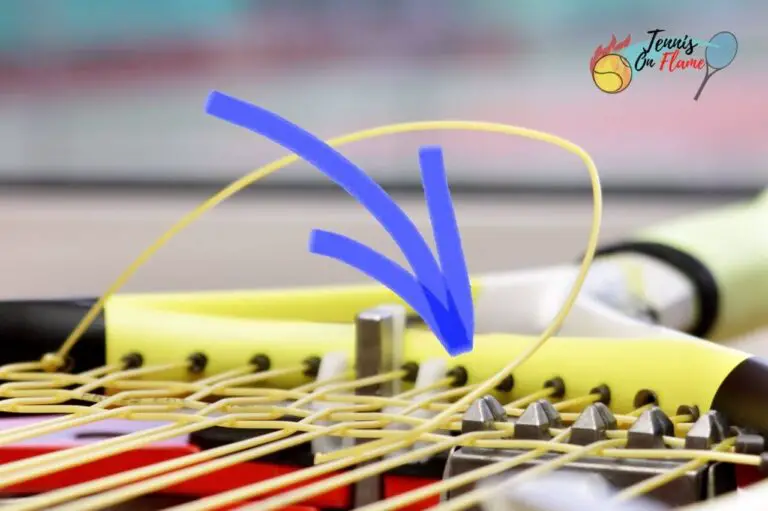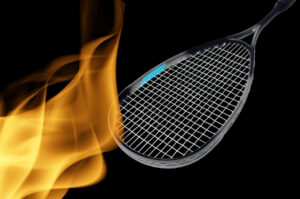How often to restring a tennis racket is a question that many players ask:
If you’re a tennis player, then at some point you will need to restring your racket.
How often you should do this depends on a variety of factors, including how often you play, the type of strings you use, and how well you take care of your racket.
In this guide, we will walk you through everything you need to know about restringing your tennis racket, including the different types of strings available and how to choose the right one for you.
We’ll also give you some tips on how to prolong the life of your strings.
So whether you’re a beginner or a seasoned pro, read on for all the information you need to know about restringing your tennis racket!
How often to restring a tennis racket?
The answer to this question depends on a variety of factors, including how often you play, the type of strings you use, and how well you take care of your racket.
Generally speaking, however, most players will need to restring their racket every few months.
If you’re a beginner or if you don’t play often, you may be able to get away with restringing your racket only once or twice a year.
But if you play regularly or if you use high-tension strings, you may need to restring your racket every week or even more often like every 10 to 15 hours!
It’s also important to note that the type of strings you use will affect how often you should restring them.
For example, if you use natural gut strings, which tend to be softer than synthetic strings and more susceptible to wear and tear over time (they’re also more expensive), then it’s recommended that they be replaced every few months at most since they don’t last as long even when used sparingly.

What type of strings should you get?
The short answer is: that it depends on your playing style, budget, and goals with the game.
If you’re a beginner or casual player who doesn’t play often enough to warrant investing in high-end equipment like natural gut strings – then polyester (or something similar) would probably be best for you.
They’re also much cheaper than natural gut and will last longer if they’re not used too often (i.e., less than once per week).
Other types of string that you can consider are multifilament strings, which are made of many smaller fibers that give the string more elasticity.
This makes them great for players who want more power and control from their shots.
However, they also tend to wear out more quickly than other types of strings.
If you’re a competitive player or someone who takes their tennis seriously, then you’ll likely want to invest in some high-quality strings like the natural gut.
They offer the best performance and durability, but they also come with a higher price tag.
What is the restringing process like?
The first step in any good tennis racket restring job should always involve cleaning up your strings with a damp cloth, using warm water and soap if needed.
Once they’ve been properly cleaned, you’ll want to remove any old tennis string from the frame by cutting or pulling it off at both ends of each hole (make sure not to cut through your new strings!).
When that’s done-and only then!-it’s time to start stringing the new ones through holes in order from the top left corner down, wrapping them around each other as you go along until all four ends meet up back at their starting point on either side of where they were originally tied together.
Now that your strings are ready, it’s finally time to restring!
There are a few different ways that you can go about doing this, but the most common way is to use an electric or manual stringing machine.
The process of using one of these machines is fairly straightforward: just make sure that the clamps on either side of the frame are tightened securely and then feed each end of your new strings through the appropriate hole on the machine.
Once they’re through, pull them tight and clamp them down before tightening the screws at the top to hold everything in place.
You can then cut off any excess string from each end (again-be careful not to cut your new strings!) and you’re done!
How do I know when it’s time to restring my tennis racket?
If you’re not sure whether or not your tennis racket needs a new string job, there are a few things that you can look for to help you make the decision.
One of the most obvious signs is if any of the strings have snapped or started to come loose from the frame.
If the frame of your racket is also starting to show visible wear and tear, then it’s likely time for a new one.
You can also test the tension of your strings by plucking them gently with your fingers if they’re too loose, then it’s time for a restring.
Last but not least, if you’re not getting the same power and accuracy from your shots that you used to, it could be a sign that your strings need to be replaced.
How do I restring my tennis racket?
There are a few different ways that you can go about restringing your tennis racket, depending on what you want and how much time you have available.
If you’re looking for something simple, then an electric or manual stringing machine will do the trick.
These machines make it easy to restring your racket in about half an hour or less!
You’ll also save some money by not having to pay someone else for their services.
However, if you’re feeling adventurous or want to try a new technique, there are also a few ways that you can do it by hand.
This involves using some basic tools like pliers, clamps, and scissors, and it can be a little more time-consuming (it usually takes around two hours).
But honestly, I recommend you to ask a professional to do it for you.
How much does the restringing service cost?
The average price for a string job is around $25-$30, but it can vary depending on where you get your racket done and how long they’ve been in business.
For example, some local pro shops may charge less while others will charge more if they have to travel to your location.
In general, the more complicated the restringing process is, the higher the cost will be.
Are there any other benefits to getting my tennis racket restrung?
Besides the obvious benefit of having a freshly-strung racket that performs better on the court, there are a few other reasons why you might want to consider getting your tennis racket restrung.
One is that it can help to extend the life of your racket.
If you’re using old or worn-out strings, they can damage the frame of your racket over time.
Replacing them with fresh new strings can help to prevent this from happening.
Another benefit is that it can help to improve your game by giving you more power and control over your shots.
So if you’re looking for a little extra edge on the court, getting your tennis racket restrung may be just what you need!
How long do tennis racket strings usually last?
The lifespan of tennis racket strings varies depending on how often they’re used, the type of string, and the weather conditions.
On average, they usually last around two to three months before they need to be replaced.
However, this can vary greatly so it’s always a good idea to check them regularly for any signs of wear and tear.
How to tell if a tennis racket needs restringing?
Here are some examples of signs that should tell you that your rackets need restringing:
-If any of the strings have snapped or started to come loose from the frame
-If the frame of your racket is also starting to show visible wear and tear
-If you’re not getting the same power and accuracy from your shots that you used to
-Just look at the strings and see if they are all frayed and worn out
What is the best string tension for a tennis racket?
The best string tension for your racket depends on how hard you hit, which hand you play with (right or left), and what type of player you are (offensive or defensive) among other factors.
If we were talking about the best string tension for a beginner, then below 50 pounds would be ideal since they don’t usually hit with much power yet.
For intermediate and advanced players who hit harder shots more often, between 60-75 pounds is recommended to give them better control over their strokes while still being able to put enough spin on the ball when needed.
I recommend you to check out my guide about string tension for a tennis racket.
In conclusion,
There are a few things that you need to know about how often to restring your tennis racket.
First, it’s easy to do it yourself if you’re handy with tools and want to save some money – but it is always better to go for a professional service.
Second, the average lifespan of strings is around two to three months but this can vary depending on how often you play tennis and what type of player are you (offensive or defensive).
Thirdly, there’s no right answer when asked “how often should I restring my tennis racket” since it all comes down to how hard you hit the ball and how much you are playing.
However, following the general guidelines above should give you a good idea of when it’s time to get a new set of strings.
Last but not least, always inspect your racket for any signs that it needs restringing, and remember that getting a professional service done every once in a while is always a good idea to keep your racket performing at its best!








